

Super Nintendo Entertainment System:SNES (1991) The SNES is Nintendo's second home console, following the Nintendo Entertainment System (NES).

The console introduced advanced graphics and sound capabilities compared with other systems at the time. The development of a variety of enhancement chips integrated in game cartridges helped to keep it competitive in the marketplace. History[edit] Early concept designs for the SNES, referred to as the "Nintendo Entertainment System 2". Launch[edit] Sega Saturn (1995) History[edit] Background[edit] Development[edit] According to Kalinske, Sega of America "fought against the architecture of Saturn for quite some time".[21] Seeking an alternative graphics chip for the Saturn, Kalinske attempted to broker a deal with Silicon Graphics, but Sega of Japan rejected the proposal.[22][23] Silicon Graphics subsequently collaborated with Nintendo on the Nintendo 64.[22] Kalinske, Sony Electronic Publishing's Olaf Olafsson, and Sony America's Micky Schulhof had previously discussed development of a joint "Sega/Sony hardware system", which never came to fruition due to Sega's desire to create hardware that could accommodate both 2D and 3D visuals and Sony's competing notion of focusing entirely on 3D technology.[23][26] Publicly, Kalinske defended the Saturn's design: "Our people feel that they need the multiprocessing to be able to bring to the home what we're doing next year in the arcades.
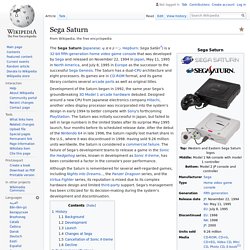
" Launch[edit] A first model Japanese Sega Saturn unit. Wing Commander (1990) Screenshot showing the cockpit of the player's ship and a targeted enemy in an outer space setting.

Gameplay consists of completing successive missions and overall cockpit performance affects gameplay: going above and beyond the call of duty results in medals, promotions in rank are awarded at regular intervals, and success or failure on certain critical missions decides the player's plot progress, "winning" or "losing". In the add-on's plot, the Tiger's Claw, on maneuvers in the Goddard System, receives an abortive distress call from Goddard colony. When the Claw arrives, though, nothing is left but wreckage and corpses; a quarter of a million colonists have been killed. King's Bounty (1990) King's Bounty is a turn-based fantasy computer and video game designed by Jon Van Caneghem of New World Computing in 1990.
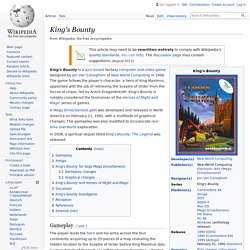
The game follows the player's character, a hero of King Maximus, appointed with the job of retrieving the Sceptre of Order from the forces of chaos, led by Arech Dragonbreath. King's Bounty is notably considered the forerunner of the Heroes of Might and Magic series of games. A Mega Drive/Genesis port was developed and released in North America on February 21, 1991, with a multitude of graphical changes. The Little Mermaid (1991) When a stage begins, Ariel descends from the top of the screen to the recommended starting point in the NES version, but just starts out in the recommended position in the Game Boy version.

The featured SFX are different in both versions. The start of the stage's BGM can be heard only once in the NES version; although the whole BGM can be repeated in the Game Boy version. Sonic the Hedgehog (1991) The game's development began in 1990, when Sega ordered its AM8 development team to create a game featuring a mascot for the company.
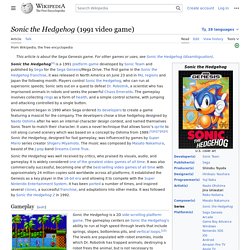
After considering a number of suggestions, the developers decided on a blue hedgehog with spikes along his head and spine and renamed themselves "Sonic Team" to match their character. Sonic the Hedgehog, designed for fast gameplay, was influenced by the games of Super Mario series creator, Shigeru Miyamoto. Sonic the Hedgehog uses a novel technique that allows Sonic's sprite to roll along curved scenery, which originated in a tech demo created by the game's programmer, Yuji Naka. Jump up ^ While this cover was also sold in some parts of Canada, a Canadian exclusive variant, which models the PAL cover, does existJump up ^ Sonic the Hedgehog (Japanese: ソニック・ザ・ヘッジホッグ, Hepburn: Sonikku za Hejjihoggu?) Jump up ^ Known as Dr. Lemmings (1991) The objective of the game is to guide a group of anthropomorphised lemmings through a number of obstacles to a designated exit.
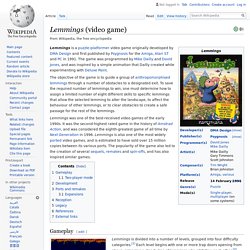
To save the required number of lemmings to win, one must determine how to assign a limited number of eight different skills to specific lemmings that allow the selected lemming to alter the landscape, to affect the behaviour of other lemmings, or to clear obstacles to create a safe passage for the rest of the lemmings. Lemmings cross a bridge and tunnel through a rock formation in the Amiga version In two-player mode, each player can only control lemmings of their own colour but attempt to guide any lemming to their own goal. The original Lemmings walk-cycle sprite animations from Mike Dailly (left) and Gary Timmons' improved version on the right. The animation was done using an 8×10 pixel space, with Timmons' version showing a less stiff walk cycle. Another World (1992) Another World, also known as Out of This World in North America and Outer World (アウターワールド, Autā Wārudo?)
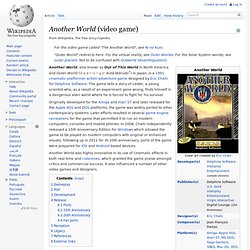
In Japan, is a 1991 cinematic platformer action-adventure game designed by Éric Chahi for Delphine Software. The game tells a story of Lester, a young scientist who, as a result of an experiment gone wrong, finds himself in a dangerous alien world where he is forced to fight for his survival. Another World was highly innovative in its use of cinematic effects in both real-time and cutscenes, which granted the game praise amongst critics and commercial success.
It also influenced a number of other video games and designers. Flashback (1992) Flashback, released as Flashback: The Quest for Identity in the United States, is a 1992 science fiction cinematic platform game developed by Delphine Software of France and published by U.S.
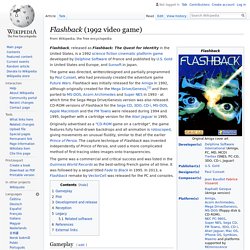
Gold in United States and Europe, and Sunsoft in Japan. Conrad, left, fighting two corrupt cops (Sega Mega Drive/Genesis version) Conrad also carries a pistol with unlimited ammunition, a force shield which absorbs a certain number of shots before needing recharging, acting as Conrad's health, how many attacks he can survive before dying, and a portable force field with unlimited use, which can act as a temporary barrier to block enemies' shots. As Conrad progresses through the game's seven levels, he is increasingly presented with spatial puzzles, requiring the player to discover how to guide him toward his destination. Late in the game, Conrad receives a teleportation device, and is able to progress by throwing the device and teleporting into otherwise unreachable areas.
Mortal Kombat (1992) Mortal Kombat is an arcade fighting game developed and published by Midway Games in 1992 as the first title in the Mortal Kombat series.

It was subsequently released by Acclaim Entertainment for nearly every home video game platform of the time. Mortal Kombat is a fighting game in which players battle opponents in one-on-one matches. The fighter that completely drains the opponent's health bar first wins the round, and the first to win two rounds wins the match. Each round is timed; if both fighters still have health remaining when time runs out, the one with more health wins the round. Players select one of seven characters. Alone in the Dark (1992) Alone in the Dark is considered a forefather of the survival horror genre, and its influence can be seen on the Resident Evil franchise. Alone in the Dark has also spawned four follow-up games as part of the series, as well as two movies loosely based on them.
A screenshot with Edward Carnby Players choose between a male or female protagonist (Edward Carnby or Emily Hartwood respectively), and are then trapped inside the haunted mansion of Derceto. The player character starts in the attic, having ascended to the top of the mansion without incident, and is tasked with finding a way out of the mansion while avoiding, outsmarting or defeating various supernatural enemies including slave zombies and giant bipedal rat-like creatures. Though able to kill most enemies with simply fists and feet, the player character can also find and utilize weapons. The player character can search any area, open and close doors, push certain objects, and pick up some items.
The Lost Vikings (1993) Wolfenstein 3D (1993) Gameplay[edit] In-game screenshot of the DOS version, showing the player character firing a submachine gun at guards Plot[edit] Wolfenstein 3D is divided into two sets of three episodes: "Escape from Castle Wolfenstein", "Operation: Eisenfaust", and "Die, Führer, Die! " serve as the primary trilogy, with a second trilogy titled The Nocturnal Missions including "A Dark Secret", "Trail of the Madman", and "Confrontation". The protagonist is William "B.J. " The Nocturnal Missions form a prequel storyline dealing with German plans for chemical warfare. An additional episode entitled Spear of Destiny was released as a retail game by FormGen.
Development[edit] Doom (1993) As the last man standing, the player character's mission is to fight through the entire onslaught of demonic enemies by himself in order to keep them from attacking Earth. Knee-Deep in the Dead, the first episode and the only one in the shareware version, is set in the high-tech military bases, power plants, computer centers and geological anomalies on Phobos. It ends with the player character entering the teleporter leading to Deimos, only to be overwhelmed by monsters. The Settlers (1993)
The Settlers (German: Die Siedler) is a 1993 real-time strategy video game developed and published by Blue Byte Software for Amiga. In 1994, it was ported to MS-DOS. Blue Byte published the DOS version in Europe under its original title, but in North America, it was published by SSI as Serf City: Life is Feudal. Due to the complexities of writing a codebase which understood and could realistically duplicate the nature of supply and demand, as well as ensuring the computer could handle military and economic matters simultaneously, the game took over two years of development and programming. Myst (1993) Not to be confused with mist. Disney's Aladdin (1993) The Amiga and PC versions (DOS) were based on the Mega Drive/Genesis version, featuring enhanced music and sound effects. Warcraft: Orcs & Human (1994)
Warcraft: Orcs & Humans is a real-time strategy game (RTS), developed by Blizzard Entertainment and published by Blizzard and Interplay Entertainment. Blackthorne (1994) Blackthorne (released as Blackhawk in some European countries) is a cinematic platformer video game developed by Blizzard Entertainment.
It was released for the SNES and MS-DOS in 1994.[1] The cover art for the SNES version was drawn by Jim Lee.[2] In 2013, the game was added to server us.battle.net as a free download, emulated through DOSBox.[3] Blackthorne is set on the planet Tuul, which has existed for centuries without human knowledge. All of this time, Tuul's people have been ruled over by a single shaman who "was blessed with all knowledge". Years before the game begins, Thoros, the latest ruler, finds it near impossible to choose between his two sons as the next ruler.
Believing it will solve the dilemma, he leads them to the deserts and kills himself. Gameplay[edit] The game focuses around protagonist Kyle "Blackthorne" Vlaros, out for revenge on Sarlac and his minions. Ports[edit] Reception[edit] References[edit] External links[edit]